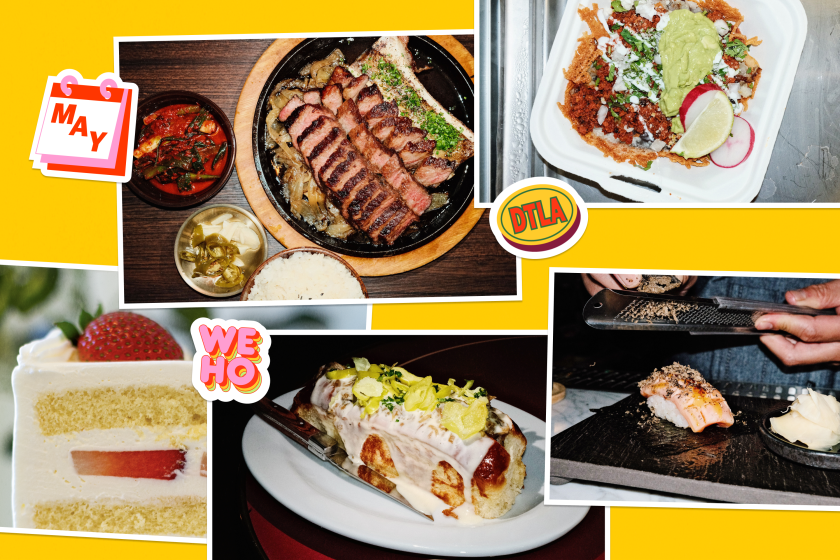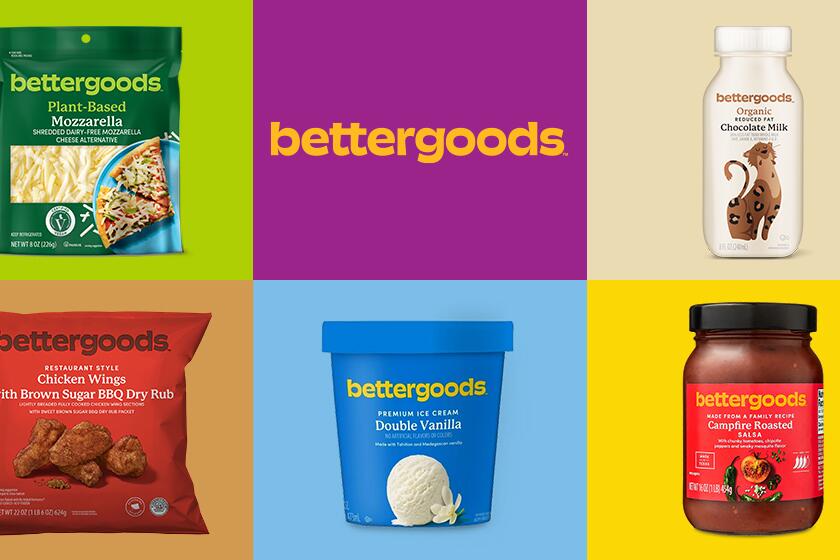Against the Grain
You never completely consider how delicious that bowl of fresh fettuccine is or how incredible that still-warm bagel tastes. Never, that is, until you have to say, “Never again.”
What if, by some cruel twist of time and genetics, wheat were suddenly out of your diet forever? Wheat, as in flour, pastry flour, cake flour and dough; wheat, as in homemade muffins, freshly baked pies, towering cakes and pizzas to go.
I know the answer from personal experience. It is a disaster.
Five years ago, pursuing a diagnosis to an increasingly debilitating--and mysterious--health problem, I went to my internist only to hear those most disheartening words: “I don’t have a clue what’s wrong with you.”
My chiropractor had told me earlier that I was allergic to flour. (“How can I be allergic to wheat--something I’ve eaten all of my life?”) So, out of desperation and remembering what my chiropractor had said, I cold-turkeyed pasta, pizza and apple pan dowdy. Within three days of abstinence from the golden shaft, my energy returned, and my flu-like symptoms and headaches left me, never to return--until I unwittingly ingested more of the stuff.
Those with a wheat sensitivity or a food allergy in general seem to be growing in numbers, but it just may be that the recognition of this condition is what is on the rise. The top four allergies in the United States are milk, eggs, wheat and corn.
In his book, “Coping With Food Allergy,” allergist Claude A. Frazier MD asserts that wheat allergy problems account for 30% to 50% of the clients that allergists see.
Given how much wheat is eaten in this country, it is easy to see why: The more you eat of a particular food, the more likely your propensity to become allergic to it some day.
Be aware that there is a wide range of sensitivity between the true celiac and the person who feels a little foggy the day after eating a pizza.
Here are five recipes that anyone off wheat will truly crave, and anyone looking for a change will surely enjoy.
*
This recipe--adapted from “The Gluten-Free Gourmet: Living Well Without Wheat” by Bette Hagman (Henry Holt)--is the only wheat-less recipe I have ever found that makes delicious yeast bread. It works equally well made in the traditional way or in a bread maker. Two things you really need, GF flour mix and xanthan gum, are available from Ener-G-Foods Inc., P.O. Box 24723, Seattle, Wash. 98124-0723; (800) 331-5222.
Or you can make your own flour by combining 2 cups white rice flour, 2/3 cup potato starch flour and 1/3 cup tapioca flour. (Do not, as I have, try to make your own tapioca flour from tapioca. The little balls just never go away.) Xanthan gum replaces gluten in the flour. Be forewarned that it gives some people (me included) a bit of gas, but the taste and texture of the bread are worth it. Also, you can substitute equal amounts of honey for the 1/4 cup sugar in the recipe (not for activating the yeast), if you want.
TRUE YEAST BREAD
3 cups GF flour mix
1/4 cup plus 2 teaspoons sugar
3 1/2 teaspoons xanthan gum
2/3 cup dry milk powder
1 1/2 teaspoons salt
1/2 cup lukewarm water
1 1/2 yeast cakes or 1 1/2 tablespoons dried yeast
1/4 cup shortening
1 1/4 cups water
1 teaspoon vinegar
3 eggs
Combine flour, 1/4 cup sugar, xanthan gum, milk powder and salt in bowl of heavy-duty mixer fitted with bread hook.
Dissolve remaining 2 teaspoons sugar in 1/2 cup lukewarm water and mix in yeast. Set aside about 5 minutes.
Combine shortening and 1 1/4 cups water in saucepan and set over medium heat until shortening melts.
Turn mixer on low to combine dry ingredients. Slowly add shortening-water mixture and vinegar, mixing until blended. Beat in eggs. Mixture should feel slightly warm to touch. Pour yeast mixture into ingredients in bowl and beat at highest speed 2 minutes.
Cover mixing bowl with plastic wrap and kitchen towel and place in warm place to let dough rise until doubled in size, 1 to 1 1/2 hours. Spoon dough into 3 small (5x2 1/2-inch) greased loaf pans or 1 large 9x5x3-inch pan. (Use greased muffin tins to bake any remaining dough as small rolls.) Dough texture will seem more like cookie dough than bread dough.
Place pans in warm place and let rise until dough is slightly above top of pan. Bake at 400 degrees 10 minutes. Place foil over bread and bake large loaf 50 minutes longer, small loaves 30 to 40 minutes, and rolls, if any, about 25 minutes. Remove from pans and place on rack to cool. Makes 3 small (5x2 1/2-inch) loaves or 1 large loaf plus several small rolls, 9 servings.
Each serving contains about:
297 calories; 461 mg sodium; 83 mg cholesterol; 10 grams fat; 47 grams carbohydrates; 7 grams protein; 1.56 grams fiber.
*
How many nights have I dreamed of those perfect pizzas of my youth? Plenty. The following recipe is the least-ersatz substitute I have been able to concoct. The crust comes from “Gluten-Free Cooking” by Pat Garst, and the topping is based on one by food writer Abby Mandel. The crust reminds me of the glory days, and the topping does the rest. I’ve served it to unsuspecting company as an appetizer to good reviews. Don’t knock Parmesan cheese in place of mozzarella until you’ve tried it.
PIZZA AT LAST
1 1/2 teaspoons fast-rising dried yeast
About 1 cup warm water, 105 to 115 degrees
1 teaspoon sugar
2/3 cup rice flour
1/3 cup potato starch
1 1/2 teaspoons solid shortening, melted
1 teaspoon salt
Hot Tomato Topping
Grated Parmesan cheese
Basil leaves
Dissolve yeast in large bowl in 1/2 cup warm water with sugar added. After yeast has doubled in size, about 5 minutes, mix in flours, shortening and salt. Use enough remaining 1/2 cup warm water until dough achieves consistency of cake frosting that spreads but does not run.
Grease 15x10-inch jelly roll or baking pan. Pour batter down center and spread evenly with spatula into circle. Raise edges slightly. Spread with Hot Tomato Topping and sprinkle with grated Parmesan cheese to taste. Bake at 425 degrees until done, 25 to 30 minutes. Remove from oven. Garnish center with basil leaves. Makes 4 to 6 servings.
Each of 4 servings contains about:
398 calories; 1,380 mg sodium; 20 mg cholesterol; 11 grams fat; 63 grams carbohydrates; 17 grams protein; 3.31 grams fiber.
Hot Tomato Topping
4 sweet red peppers
4 pounds ripe tomatoes
3 cloves garlic
1 teaspoon honey
1/2 teaspoon salt
1/2 teaspoon hot red pepper flakes
3 sprigs basil
1 to 1 1/2 cups Parmesan cheese
Core and seed red peppers and cut into strips. Place peppers on foil-lined baking sheet, skin-side up, and place under broiler until skin is blackened, 8 to 10 minutes. Remove to cool. Peel off skins.
Cut tomatoes into sections, but do not remove seeds and juice. Puree 1/3 of peppers, tomatoes and garlic in blender or food processor. In two batches, repeat procedure with remaining ingredients.
Transfer tomato-pepper mixture to large pan. Add honey and salt. Cook on high heat until mixture boils, then reduce heat and simmer, uncovered, until mixture is thickness of sauce, at least 1 hour. Add red pepper flakes and basil leaves, reserving 3 to 4 leaves for garnish.
*
I love these brownies, which my wife perfected. They are not only wheat-free but also sugar-free and chocolate-free. How could they be any good, you ask? The secret is in the amount of vanilla added to the carob. And be sure to use roasted carob powder, not raw.
BARBARA’S INCREDIBLE BROWNIES
5 tablespoons roasted carob powder
1/3 cup butter
1 cup honey
2 eggs
3 to 4 teaspoons vanilla
3/4 cup oat flour made from about 1 cup rolled oats
1 1/2 teaspoons baking powder
1/2 teaspoon salt
1/2 cup walnuts, broken into pieces
Melt together carob powder and butter in medium saucepan over low heat, stirring until thoroughly mixed. Beat together honey and eggs in small bowl. Slowly add carob mixture and beat until blended. Stir in vanilla.
Pulse 1 cup rolled oats in blender until it turns into flour, about 30 seconds. Sift flour along with baking powder and salt into second bowl. Add walnuts. Stir in carob mixture, using spatula to blend together. Pour mixture into greased 8-inch-square baking pan.
Bake at 350 degrees 25 minutes. Brownies are done when mixture is cake-like and 2 inches in from pan’s edge. Center section will be more gooey. Cool 10 to 15 minutes. Cut into squares. If squares are too soft to cut, refrigerate 15 minutes or more, until firmer. Makes 16 brownies.
Each serving contains about:
156 calories; 162 mg sodium; 37 mg cholesterol; 7 grams fat; 24 grams carbohydrates; 2 grams protein; 0.41 gram fiber.
Note : Oat flour may be purchased at grocery store.
*
Breakfast can be an especially scary time for the wheat-sensitive. Breakfast cereals, sweet rolls, bagels, toast--everything seems to have wheat. Here’s a favorite recipe from Barbara Luboff, a registered dietitian in Los Angeles, who also has a wheat sensitivity. The recipe uses millet, a grain that is wonderful to work with and tasty to boot.
WHEAT-FREE HEALTHY PANCAKES
1/2 cup millet
1/2 cup rice flour
1 teaspoon baking soda
1 teaspoon cream of tartar
1 teaspoon arrowroot
1/2 teaspoon apple pie spice or ground cinnamon
1/2 cup applesauce
1/3 cup apple juice concentrate
2 egg whites, unbeaten
4 to 6 tablespoons water
Vegetable cooking spray
1/2 apple, peeled and sliced
Stir together millet, rice flour, baking soda, cream of tartar, arrowroot and apple pie spice in medium bowl.
Mix together applesauce, apple juice concentrate, egg whites (reserve egg yolks for another use) and water in separate bowl. Stir dry ingredients into wet ingredients until blended.
Spray non-stick skillet or griddle with vegetable cooking spray. Use less than 1/4 cup batter for each standard-size pancake. Pour batter onto hot skillet to make 4 pancakes and cook until golden brown on 1 side, about 2 minutes. When pancakes have bubbly surfaces and slightly dry edges, flip over and cook 1 to 2 minutes more, or until done.
Garnish pancakes with apple slices. Serve with maple syrup, applesauce or fruit-juice-sweetened preserves. Makes 4 (4-inch) pancakes.
Each serving contains about:
229 calories; 83 mg sodium; 0 cholesterol; 1 gram fat; 48 grams carbohydrates; 6 grams protein; 0.56 gram fiber.
*
Mani Niall, owner of Mani’s Bakery in Los Angeles, was kind enough to give me this recipe. I frequent his establishment at least once a week and feel lucky to now be able to bake this treasure at home. Mani’s is the only bakery in Los Angeles that includes wheat-free delights. And he uses no sugar, though you’d never know it.
BARLEY SCONES
4 1/4 cups barley flour
1 1/2 teaspoons baking soda
1/2 teaspoon ground cinnamon
1/2 teaspoon ground nutmeg
3/4 cup favorite fruit juice concentrate
1/2 cup canola oil
2 eggs
1/4 cup nonfat milk
2 teaspoons grated orange zest
1 cup raisins or currants
1 egg beaten with 1 tablespoon water or 2 tablespoons milk, optional
Sift together barley flour, baking soda, cinnamon and nutmeg. Set aside.
Mix together fruit juice concentrate, canola oil, eggs, nonfat milk and orange zest, either by hand, using wire whisk, in heavy duty mixer using flat beater or with electric hand-held beater. Mix until well blended, 1 to 2 minutes.
If using heavy duty mixer, turn speed to low, add dry ingredient mixture and fold in raisins. If using wire whisk or hand-held beater, fold in dry ingredients and raisins by hand. Batter will be very sticky and gooey compared to most traditional scones.
Line 2 baking sheets with parchment paper or spray with vegetable cooking spray. Divide batter into 4 portions and mound each onto prepared baking sheets. Scoop batter with ice cream scoop onto prepared baking sheets. Dip palms of hands into water (to prevent sticking) and press batter down to 1/2-inch thickness. Brush scones with egg wash for shinier appearance. Bake at 375 degrees until golden brown, 20 to 30 minutes. Serve warm. Makes 4 large scones.
Each serving contains about:
1,178 calories; 74 mg sodium; 107 mg cholesterol; 33 grams fat; 206 grams carbohydrates; 25 grams protein; 2.12 grams fiber.
More to Read
Eat your way across L.A.
Get our weekly Tasting Notes newsletter for reviews, news and more.
You may occasionally receive promotional content from the Los Angeles Times.






